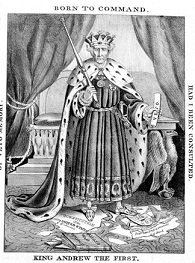Assignment:
Part. 1: Era of Good Feelings: Maysville Road Bill
The Maysville Road Project was a project proposed as part of Henry Clay's American System. The federally funded turnpike would unite Louisville and Maysville in Kentucky, two major cities on the Ohio River. Congress passed the bill in 1830. The bill authorized for the federal government to purchase $50,000 worth of stock in a private company who would build the turnpike.
President Jackson quickly vetoed the bill. Jackson felt the project was unconstitutional because he said the federal government didn't have the right to fund an intrastate (within a state) project. Jackson contended an intrastate project didn't benefit the entire country.
He wrote this to Congress when he vetoed the bill.
I have maturely considered the bill proposing to authorize "a subscription of stock in the Maysville, Washington, Paris, and Lexington Turnpike Road Company and now return the same to the House of Representatives . . . with my objections to its passage . . . such grants have always been professedly under the control of the general principle that the works might be thus aided should be "of a general, not local, national, not State," character. A disregard of this distinction would of necessity lead to the subversion of the federal system.
Questions:
1. Do you believe President Jackson's veto of the Maysville Road Bill was the appropriate action? Defend your answer.
2. Suppose you were a supporter of the American System. How could you modify the bill to make it acceptable to Jackson?
Part. 2:
What if there were only one political party in the United States?
The Era of Good Feelings was a short period in American history where there was only one viable political party in power. What if there were only one party in power in American politics today. Would it create a different climate in politics or would it be the same. Reflect on this concept and then answer the question. Hypothesize how this would affect government.
Part. 3: Labor Rules
Use the two pdfs (Plantation Management and Lew_rules) to fill in this comparison chart on Mill Life and Plantation Life. If there is an * (asterisk) if the box it is not mentioned specifically in the reading, but you may draw from your former knowledge and common sense to make a statement; i.e. if a subject is not mentioned at all, it may be that the service isn't provided.
|
Characteristic
|
Lewis Mill
|
De Bow's Plantation
|
|
What hours of labor were expected by the workers?
|
|
|
|
How was sickness of a laborer reported/handled?
|
|
|
|
What were the terms or contract of the employment of the laborers?
|
|
*
|
|
What are the provisions for the care and welfare of the workforce?
|
*
|
|
|
What are the personal restrictions placed on the laborers?
|
|
|
|
How is theft by a worker punished?
|
|
*
|
Part. 4: Child Labor
Comparison of Child Slave Labor and Child Industrial Labor
Instructions: Determine whether the statement refers of Child Labor in the Industrial North or Child Slave Labor in the Agricultural South.
Mark N for Industrial North or S for Agricultural South.
1. Child worked in mills and mines.
2. Child was the property of the plantation owner.
3. Child earned a small wage along with the rest of his/her family.
4. Child could leave with his/her family and relocate by choice.
5. Child either worked in the fields or in the home of his/her owner.
6. Child could be sold away from his /her family.
7. The work around machinery was dangerous and child could lose life or limbs.
8. If child disobeyed the mill manager he/she could be fired or whipped.
9. If a child ran away he/she could be hunted down and returned to the plantation.
10. Work hours were long, as much as 11 hours a day. Work conditions were unhealthy and crowded in factories. Many children died young.
11. Work conditions were usually outside in the harsh heat. Work hours were from sunup to sundown. Many children sickened from disease and died young.
Part. 5: Andrew Jackson
Interpreting a primary source document.
This is a political carton about Andrew Jackson's presidency.
Study the cartoon. You may also read through the summary provided by the Library of Congress.
Title: King Andrew the First

Summary: A caricature of Andrew Jackson as a despotic monarch, probably issued during the Fall of 1833 in response to the President's September order to remove federal deposits from the Bank of the United States. The print is dated a year earlier by Weitenkampf and related to Jackson's controversial veto of Congress's bill to recharter the Bank in July 1832. However, the charge, implicit in the print, of Jackson's exceeding the President's constitutional power, however, was most widely advanced in connection not with the veto but with the 1833 removal order, on which the President was strongly criticized for acting without congressional approval. Jackson, in regal costume, stands before a throne in a frontal pose reminiscent of a playing-card king. He holds a "veto" in his left hand and a scepter in his right. The Federal Constitution and the arms of Pennsylvania (the United States Bank was located in Philadelphia) lie in tatters under his feet. A book "Judiciary of the United] States" lies nearby. Around the border of the print are the words "Of Veto Memory", "Born to Command" and "Had I Been Consulted."
1. Name the president depicted in the cartoon.
2. What does he hold in his right hand? What point does this make?
3. What lies in tatters at his feet? What point does this make?
4. What does he hold in his left hand? What point does this make?
5. What overall view of the president does the author of the cartoon convey?
6. Would the author of this cartoon like or dislike Jackson and his policies?